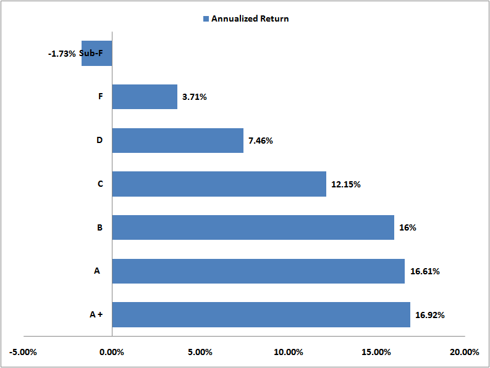Dividend Growth Stocks Can Beat High Dividend Stocks
Post on: 24 Апрель, 2015 No Comment

Lower Income In The Early Years Can Lead To Bigger Dividends In the Future
While many investors focus on dividend stocks with high yields, enjoying the passive income from the checks that the companies mail out to the owners throughout the year, there is a specialty approach within this philosophy that focuses on putting together a collection of equities that grow the dividend payments at rates substantially in excess of the rate of inflation even if the initial dividend yield isn’t particularly high. It’s called the dividend growth approach and has been used by some of the most famous money managers in history with very good results.
While it may seem counterintuitive, buying dividend growth stocks, as opposed to simply high yielding dividend stocks, is often most intelligent for younger investors who have a lot of time working for them as they can harness the power of compounding, ultimately collecting more dividend income over their life. Since this is one of those areas where providing a real world case study is likely to be the fastest way to illustrate this truth, let’s examine the historical records of two blue chip companies between the 2003-2013 time period: DuPont and Exxon Mobil.
- Back in 2003, DuPont traded at an average stock price of $40.35 per share and paid a $1.40 cash dividend for a yield of 3.46%.
- Back in 2003, Exxon Mobil traded at an average price of $36.35 per share and paid a $0.98 cash dividend for a yield of 2.70%
Imagine you ran a successful family limited partnership. You and your siblings — doctors, lawyers, accountants — have $1,000,000 you want to invest for income and you were attempting to decide between the two stocks. DuPont clearly offers a much fatter dividend, but Exxon Mobil has a history of raising its payout every year.
What would your experience have been if you opted for the high dividend yield stock versus the dividend growth stock?
The High Dividend Yield Stock: DuPont
With your $1,000,000, you were able to buy 24,783 shares of DuPont. Each year, you collected the following dividends:
- 2003 = $34,696.20
- 2004 = $34,696.20
- 2005 = $36,183.18
- 2006 = $36,678.84
- 2007 = $37,670.16
- 2008 = $40,644.12
- 2009 = $40,644.12
- 2010 = $40,644.12
- 2011 = $40,644.12
- 2012 = $42,131.10
- 2013 = $44,113.74
- Grand Total = $428,745.90
Over this period, you received dividend checks from DuPont totaling $428,745.90.
The Dividend Growth Stock: Exxon Mobil
With your $1,000,000, you were able to buy 27,510 shares of Exxon Mobil. Each year, you collected the following dividends:
- 2003 = $26,959.80
- 2004 = $29,160.60
- 2005 = $31,361.40
- 2006 = $35,212.80
- 2007 = $37,688.70
- 2008 = $42,640.50
- 2009 = $45,666.60
- 2010 = $47,867.40
- 2011 = $50,893.50
- 2012 = $59,971.80
- 2013 = $67,674.60
- Grand Total = $475,097.70
Over this period, you received dividend checks from Exxon Mobil for $475,097.70.
The Difference Should Grow Even Larger In The Future As the Dividend Growth Stock Continues To Widen the Spread
Despite starting out at a lower dividend yield, Exxon Mobil paid an extra $46,351.80 in cash dividends during the holding period. That is nearly 11% more wealth in the aggregate relative to DuPont! Plus, the owner of Exxon Mobil now has the advantage of holding a faster growing, higher quality, financially stronger business.
The really exciting part: If you calculate the dividend yield on cost. DuPont is now producing $44,113.74 on the $1,000,000, or 4.41%, while Exxon Mobil is now producing $67,674.60 on the $1,000,000, or 6.77%. Not only is the dividend growth stock producing an extra absolute 2.36% in dividend income each year, the spread between the two firms should keep growing wider. In fact, if the ratio between the two companies keeps up at its historic levels over the next decade or two, the Exxon Mobil stockholder will have collected many hundreds of thousands more dollars in cash without having to do any extra work. It’s a lot easier to build wealth and get rich when you start putting yourself in positions like that.
With investors recognizing Exxon Mobil’s superior relative growth, this looks can be deceiving relationship continues. As of the close of the stock market today, Thursday, January 30th, 2014, DuPont boasts a dividend yield of 3.00%, while Exxon Mobil is paying out only 2.70%. The dividend investor who opted for the former will likely end up with fewer dollars in his or her pocket despite the initial checks being larger.
A Few Signs To Look For In A Dividend Growth Stock
How can you spot a good dividend growth stock? Normally, it will display a few characteristics:
- The dividend payout ratio is 50% or less, and management can use the retained earnings to reinvest in a profitable core business or activity as measured by return on invested capital. Picture Sam Walton rolling out Wal-Mart stores in the early days or Walt Disney expanding his theme park.
- The company has some sort of pricing power or inflation hedge that allows it to raise prices at a rate slightly higher than inflation itself.
- When the stock is cheap, management will return surplus funds to stockholders by repurchasing shares. In future years, this means the dividend has to be divided among fewer shares outstanding, so it’s possible to increase the per share rate much quicker than would otherwise be the case.
Many investment research firms, such as Value Line or S&P, provide lists to their clients and subscribers detailing the stocks that have enjoyed the fastest dividend growth rate over periods of 1, 5, and 10 years. They can be a great place to begin looking for potential investment ideas.














